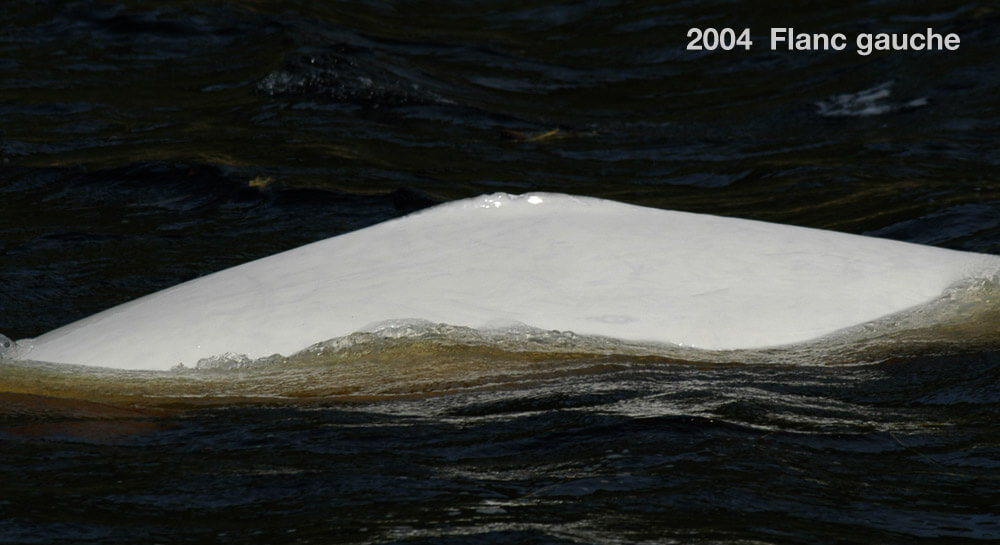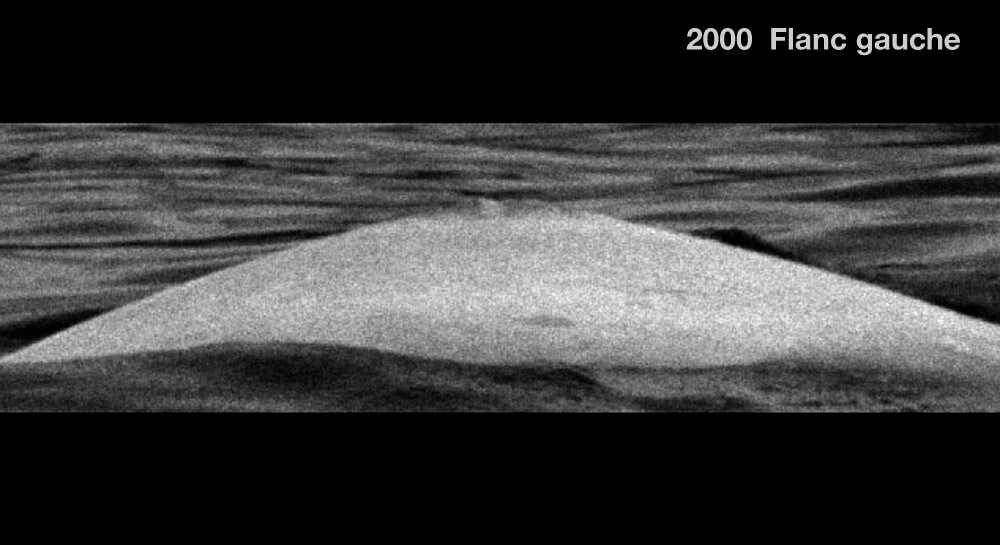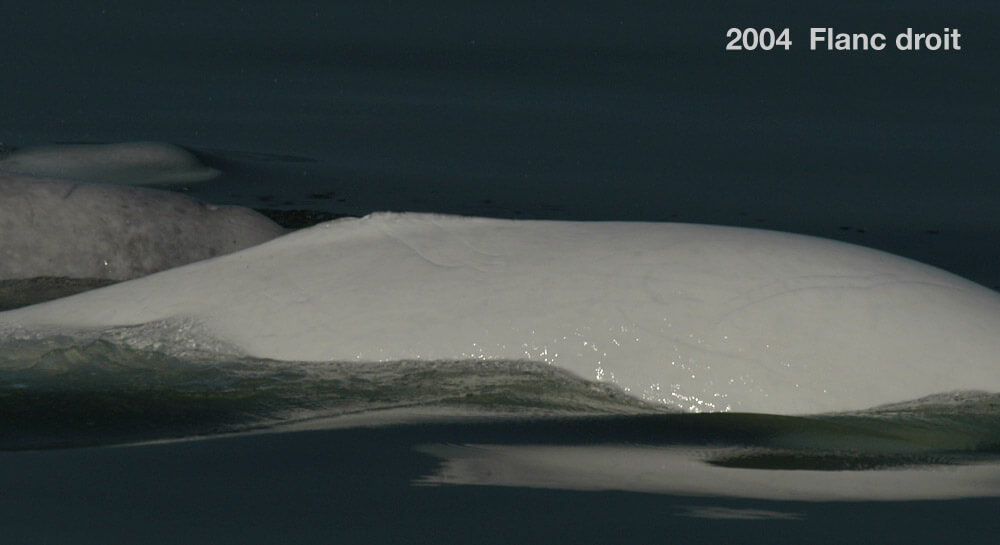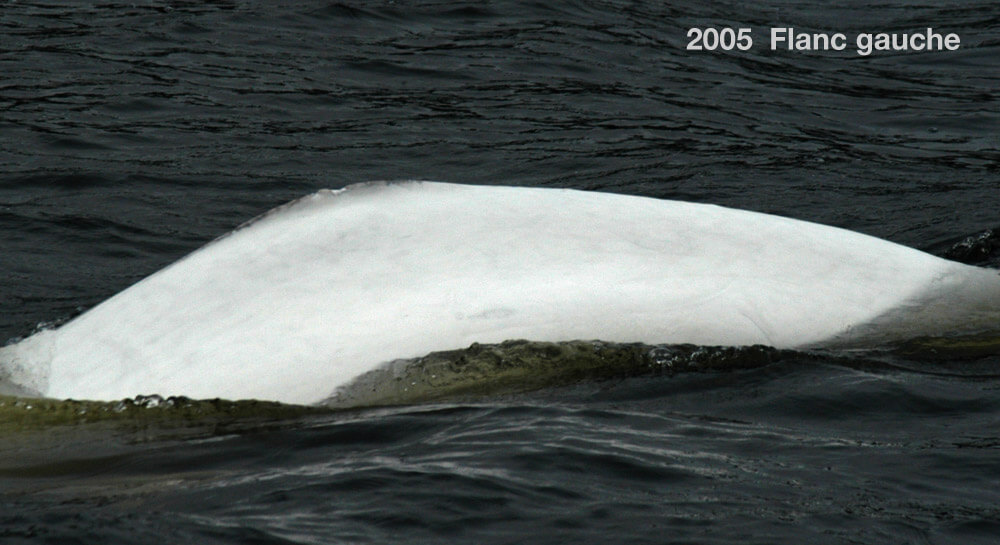DL1415
Beluga


Adopted by Great Lakes and St. Lawrence Cities Initiative
-
ID number
DL1415 (previously DL1670)
-
Sex
Unknown
-
Year of birth
Around 1990
-
Known Since
1998
Distinctive traits
DL1415 bears a small spot on its left flank that is not always easy to see. The two side-by-side gashes in the middle of its dorsal crest are also a good way to identify this beluga.
Life history
A beluga with two id numbers? Yes, we realized that DL1670 was also DL1415. By tradition, we merge the two identity cards under the first number, therefore DL1415.
Our first encounter with DL1415 goes back to 2000. It was slightly gray at the time but already of considerable size. It turned white a few years later (around 2004), suggesting that it was born around 1990. Belugas fade from gray to white in colour between the ages of 12 and 16.
From 2005 onward, its frequent associations in herds comprising exclusively adults lead us to believe that DL1415 is a male. Indeed, there exists a sort of sexual segregation in belugas. Particularly in summer, bulls and cows live separately and frequent different sectors. Although it is not rare to see males join up with herds of females and young, it is especially unusual to observe females in herds composed predominantly of males.
DL1415 is regularly observed near the mouth of the Saguenay. It might belong to one of the two male networks of the Saguenay. Members of these networks do not intermingle with other male networks, even if their territories do overlap. As the years pass, males have a tendency to form stable groups of companions. These associations may play a role in belugas’ reproductive lives. DL1415 is a young male, however, who is not yet known to have a devoted companion.
How DL1415’s story unfolds will teach us volumes on the evolution of belugas’ social lives. By better understanding how belugas live, we will better be able to protect them.
Observations history in the Estuary
Years in which the animal was not observed Years in which the animal was observed
Latest news
Off Ile Rouge, at the mouth of the Saguenay Fjord, a herd of 100 to 110 individuals has been spotted. The herd is composed mainly of adults, possibly all males. DL1415 was spotted among the individuals. We attempt a biopsy, but unfortunately the arrow passes just above his dorsal crest. Aiming at a moving target on a moving platform is no mean feat. We’ll have to wait for another opportunity to get that little bit of skin and fat that will confirm whether our suspicions about DL1415’s sex are right, and reveal many other secrets. During the course of this encounter, however, we managed three biopsies on other belugas. A successful day!
Aboard the BpJAM research dinghy, we’re out today to survey the large whales, but we’ve also been instructed to photograph any belugas we come across along the way. We encounter a herd of white whales between the Alouettes flats and the Tadoussac “dunes”, which are in fact marine terraces. We count about 15 belugas, including some that are still gray, i.e. young. Among the belugas, we photographed DL1415, with minke whales feeding on the surface, attracting the attention of cruisers and yachtsmen. To reduce the pressure on the whales, we choose to continue on our way.
August 30, 2012: near Anse à la Boule in the Saguenay, we cross paths with a herd numbering some forty individuals. The herd is noted to be disparate, comprising adults, young and four calves. The majority of the animals are alone, except the females and calves, who are swimming in two isolated groups. The solitary animals are probably males, based on their size and behaviour; DL1415 is identified amongst them.
September 6, 2010, frankly, it’s not an ideal day for beluga photo-identification. The wind is blowing hard, and the (white) sheep are adding to the reflections, making it harder to see the (white) belugas. We set course for the fjord, hoping for calmer weather. We find a herd of around 40 individuals, made up of adults and calves, near Baie-Sainte-Catherine. The belugas are very active, with lots of surface activity such as spitting and tail wagging. Some belugas appear sideways, revealing half their belly. DL1415 is in a group of 10 individuals, including whites (adults), dirty whites (young adults) and well-built grays (teenagers). Also in the same group are DL2319, DL2453, DL2452 and Neo. While the belugas were very active a few seconds earlier, they seem to have evaporated. We wait 10 minutes, but they don’t reappear through the waves. We decide to continue on our way in search of other animals.
DL1415 is recognized among some forty individuals, mostly white adults. Since his first identification, this young male beluga has usually been seen at the mouth of the Saguenay, which leads us to believe that he could be part of one of the two networks of males in the Saguenay. Today, he is in the company of Trèfle and other males belonging to the downstream network, the “downstream boys” as they are known. We believe there are few encounters between males from different networks, but definitive membership of a network could be established late in the belugas’ lives… To be continued!






